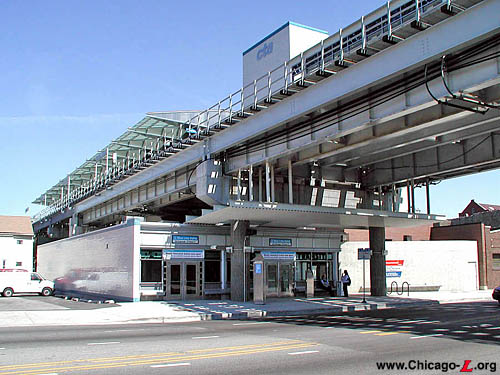
The Western station house,
elevator tower, and island platform canopy are seen looking
southeast on reopening day, June 4, 2004. The station
features a new, modern station house in the same location of
the previous one and wider accessible island platform, all
executed in a postmodern design. For a larger view, click
here.
(Photo by Graham
Garfield)
|
Western
(2400W/2100S)
Western Avenue and 21st
Street, Lower West Side
Service
Notes:

|
Pink Line:
Cermak (Douglas)
|

|
Accessible
Station
|
Quick Facts:
Address: 2009 S. Western
Avenue
Established: August 7, 1896
Original Line: Metropolitan West Side Elevated, Douglas
Park branch
Previous Names: none
|
Skip-Stop Type:
|

|
Station
(1951-1958)
|

|
Station
(1958-1995)
|
Rebuilt: c. 1935 (new
station house facade), 2002-04
Status:
In Use
History:
The Douglas Park branch of the Metropolitan West Side Elevated
Railroad (the 'Met') was originally planned to extend to 46th
(Kenton) Avenue in its original stretch. The branch, however,
actually opened in incremental stages. On April 28, 1896, the branch
opened between Marshfield Avenue junction, where it left the Met main
line, and 18th Street. Just over three months
later, on August 7, 1896, service was extended to Western Avenue.
Western remained the terminal of the branch for six years, until the
next extension opened on March 10, 1902, though the station was not
designed in any appreciable way to serve as a terminal. In fact, it
was designed in the same configuration was most other "through"
stations and simply functioned as a stub-end terminal.
The original station was typical of those on the original 1896
portion of the Douglas Park branch, a largely rectangular building
with a bay extending approximately five feet in front of the
building. The one-story headhouse, situated beneath the elevated
structure, employed an unusual vernacular form with influences from
the Craftsman and even Prairie School styles. The exterior walls were
clad in dark red/brown bricks while a rusticated stone base lined the
bottom of the wall at ground level while the corners had stone
quoins. The Craftsman influences came through in the wide overhanging
eaves with exposed rafters and the battered half-timbered treatment
over the front entrance, while the Prairie School style can be seen
in the low pitched roof, extended eaves (one of several qualities
shared with the Craftsman) and tall, thin, banded windows on the side
elevations.
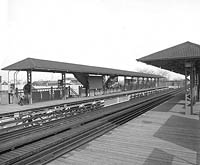
The side platforms at
Western were typical for Metropolitan "L" stations. Seen
here on March 17, 1986, they had the standard hipped roofs
with latticed supports and brackets rafters. The outbound
platform (on the left) was twice and long as the inbound,
probably extended after the station's initial construction.
For a larger view, click here.
(CTA photo, Graham Garfield
Collection)
|
After passengers paid their fare and passed into the paid area, they
began their trek up to the platforms. One central staircase led from
the station house to a mezzanine level beneath the tracks. Part of
this central staircase was enclosed, with swinging wood and glass
doors at the top of the stairs. From this mezzanine landing, the
stairs split to the inbound and outside platforms. Each one of these
staircases also split at an intermediate level, allowing customers to
enter and leave the platform from one of two locations, a helpful
arrangement for passenger flow during heavy use rush hours. The stair
railing structure was somewhat decorative, with curved and twisted
strap metal balustrades, cast iron newel posts with small designs
cast in them and carved wooden handgrips. A series of square cast
iron plates with a square-in-square design of descending size were
placed along the bottom of the railing near the stair treads.
The dual side platforms were each nearly identical to each other
and to other Met station platforms. The flooring was treated timber
planks, while the railings and balustrades were similar to those on
the stairs. Added to the railing design here were larger cast iron
square plates with a stylized diamond design cast into them. Each
platform had a short canopy in the center of the platform, covering
the stairs and a small waiting area. The canopy frame was steel, with
latticed supports and bracketed rafters. The canopies had hipped
roofs of corrugated metal. Strung beneath the canopy roof were
incandescent lights for nighttime illumination. The platforms were
additionally lit by gooseneck lamps that were integrated into the
railing design, with certain posts extending above the railing --
above seven feet high, total -- and forming the fluted pole with a
decorative capital onto which a gooseneck light fixture with a
porcelain saucer-shaped shade with two or three incandescent light
bulbs was attached.
Art Deco Additions and Station
Modifications
As occurred with most "L" stations, several modifications were
later made to the Western station facility. Perhaps the most
important was to the front facade (west elevation). In the 1930s,
Western Avenue, the longest street in Chicago and an important
north-south thoroughfare, was widened for its entire length. The
Metropolitan Elevated had four stations along Western on various
branches and used an usual solution to the encroachment on their
property. Instead of demolishing the station houses wholesale and
erecting a new buildings further back on their property, the Met
retained their station buildings, cropped off their fronts, removed
several feet from the footprint of the structure, and added a new
front facade at the new property line. Rather than try to design a
new front to mesh with the style of the original building, the new
fronts used a radically different, decidedly modern style.
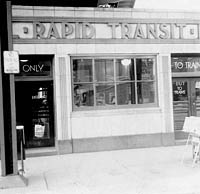
In the mid-1930s, a new Art
Deco facade was installed on Western station. One of four
stations on the system to get such a treatment, the design
was an unusually and uniquely strong application of this
style on the "L", especially with the large terra cotta Deco
lettering along the top. Seven the transoms and doors, seen
here on July 7, 1960, had Deco gold-leaf lettering. For a
larger view, click here.
(Photo from the CTA
Collection)
|
Arthur U. Gerber, by then the staff architect for Chicago Rapid
Transit Company and other Insull rail properties, designed a new
facade, which was installed circa 1935. The new Art Deco/Moderne
facade of tan and olive green glazed terra cotta and tile is a stark
contrast to the brick Craftsman side elevations. The central portion
of the street elevation contains two metal frame windows flanked on
each side by a set of swinging wood and glass doors topped with
transoms. This area is framed by a set of tan glazed piers with olive
green "piping" and topped with band containing the words "L •
RAPID TRANSIT • L" in green Art Deco lettering. The new facade
was installed by William Grace and Company. The use of the Art Deco
style for the facade was fashionable at the time, but made for a very
unusual and unique combination with the original Craftsman sides and
rear.
Although the addition of the modern facade was perhaps the most
severe change to the station, several other modifications were
performed as time went on. The interior has been largely changed
since the station house was built, with the most severe rearrangement
occurring when the Deco front was added and the building was cut
back. At the same time as the front truncation, an addition was also
put on the south side of the building to compensate for some of the
lost square footage. The walls were plaster from the ceiling to a
molding about seven feet up from the floor; below the molding, the
walls were covered with metal sheeting, at least by the time of the
station's later years. The original built-in wooden agent's booth was
removed, replaced with a small, plain, square wooden booth with a
metal screen. The interior floor was covered by a wall-to-wall
treaded rubber matting in later decades. The central portion of the
street elevation was later clad in tan glazed bricks rather than the
original terra cotta, the result of an accident circa the late 1980s.
Two modern sodium vapor lights were added at the roofline later to
add additional lighting.
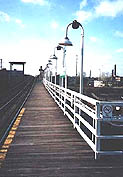
A view of one of Western's
platform extensions, this one on the westbound platform
looking west on November 19, 2000. For a larger view, click
here.
(Photo by Teresa
Heinrichs)
|
The platforms and stairs are largely intact, but have seen some
modest alterations. Metal mesh panels were later added to some parts
of the stairs to provide better protection of the stairway. The
original canopies and railings remained on the old sections of the
platforms, and the canopy on the outbound platform was later
lengthened at its east end to a point where it was about twice as
long as the inbound canopy. The platforms were extended as train
lengths got longer and the original Met platform lights were replaced
with the simpler tube pipe shepherd's crook lights there were
standard elsewhere on the system.
The Western station was an unusual and unique structure on the
Chicago rapid transit system. While there were once four such
stations on the various Metropolitan Division branches, the Douglas
branch station was the last to be removed or altered. The Humboldt
Park branch was closed in 1952 by the
CTA and subsequently
dismantled. The Garfield Park branch was razed in 1953 to make way
for the Congress (later Eisenhower) Expressway and new Congress Line
rapid transit facility, which ran in the path of the old elevated
line and included a new Western station. Until the summer of 2000,
the Western station on the
Milwaukee/O'Hare branch remained intact, but the
CTA then began a capital
improvement project to build a new station. The Art Moderne facade
and the north elevation of the original 19th century building were
salvaged but the rest was demolished, amounting to what
preservationists often call a "facadectomy." By the early 21st
century, this left the Western station on the Douglas branch the only
intact example of this very unusual architectural treatment. The
Western stations were also a rare example of the Art Moderne style on
the "L". The State Street and Milwaukee-Dearborn Subways (begun in
1938 as a WPA project and completed in 1943 and 1951, respectively)
also use an Art Moderne style in the station mezzanines, but it is a
very streamlined, simple application of the style. Western is unusual
for its more decorative take on the style and the use of Art Deco
ornamentation.
Douglas
Renovation Project
By the time of new millennium, the station was aging and in need
of renovation. Over the years, the condition of the Douglas branch
deteriorated to a point that permanent "slow zones" were present
throughout more than 47% of track and many of the stations were in
poor condition. After a long battle to secure funding from both the
state and federal governments, the
CTA decided it was time to
embark upon a complete rehabilitation of the entire branch. The
Douglas
Rehabilitation Project was the largest single capital improvement
project the authority had embarked upon up to that time. The project
was to restore the branch so that it would be 100 percent ADA
compliant with eight of the branch's 11 stations (six elevated and
two at-grade) completely rebuilt and to allow for faster travel times
from one end of the line to the other.
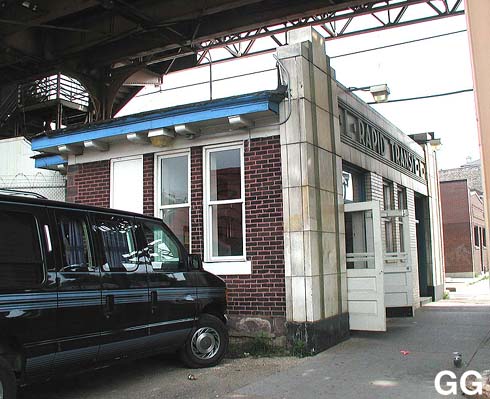
The Western station, opened
in 1896 and altered in the mid-1930s, stood as an impressive
example of mixed architectural styles and terra cotta
ornamentation in this August 1, 2001 view. For a larger
view, click here.
(Photo by Graham
Garfield)
|
As part of the renovation project, Western was replaced with an
entirely new station facility. The new headhouse is a modern glass
and steel facility on the east side of Western Avenue, where the
original station house was formerly located. The building exterior
features quarry tile at the base, a metal-frame storefront on the
front and side facades with large picture windows, glass walls and a
band of art glass along the top, and capped by a large metal cornice
divided into boxes. The art glass on the front facade reproduces the
Art Deco lettering that was on the dismantled 1930s addition. A small
plaza is located to the south of the station, in front of the
adjacent Western Substation that, in part, powers the branch's third
rail. The interior features white ceramic glazed tile walls, a
waiting area in the unpaid area with seats for waiting bus riders,
fare controls, fare vending machines, a customer assistant booth, and
various auxiliary equipment rooms.
The old side platforms are replaced with a new, wide island
platform. The new canopies were designed as "showpiece" structures,
with clear glazed roof sections that allow natural light on the
platform alternating with triangular solid, three-dimensional metal
wedges and clear triangular panels that led the canopies to be dubbed
by some as the "flying triangles". "Honeycomb" paneling adorns the
platform canopy fascia, as well as being around the various columns
and poles at platform level. A new elevator provides ADA access, with
the tall elevator tower cladded in white tiles with a blue band
around the top and a steel "cta"
on the north and south sides dominating the street elevation the
facility. The platform amenities carry through the angled motif of
the canopy, with benches, lights, windbreaks, and some signage angled
off-axis from being parallel or perpendicular to the tracks. For
customer comfort, the platform features benches, overhead heaters and
enhanced lighting. In addition to the elevator, a
wheelchair-accessible gate in the fare controls, TTY telephones,
tactile edging and Braille signs offer accessibility for customers
with disabilities. Audiovisual station signs and a public address
system help customers navigate the station and receive travel
information.
There is an auxiliary entrance and exit on the west side of
Western Avenue, across from the main station house. This
farecard-only entrance is enclosed inside a small station house whose
exterior design resembles a miniaturized version of the primary
headhouse. Inside are two high-barrier gates (HBGs), a transit
information board, and a customer assistant call button. The
auxiliary entrance is connected to the platform by way of a
platform-level pedestrian walkway bridge, which spans the width of
Western Avenue. The bridge -- with one side enclosed with a metal
framed curtain wall with glass panels and the other with a decorative
metal grille -- protects customers from inclement weather while
providing convenient, direct connections to the southbound Western
Avenue buses, the #49 and #X49.
The official groundbreaking for the Douglas
Rehabilitation Project -- also known as "Renew the Blue" -- took
place at Pulaski station on
September 10, 2001, but actual construction work did not begin at
Western station for over a year as crews worked on stations and
structure farther west. Crews began dismantling the Art Deco facade
of the Western station during the week of October 20, 2002.
Interestingly, the facade was not demolished, but seemed to be very
carefully removed piece by piece. The work was largely completed by
the end of the week.
Early in the morning at the conclusion of weekday service on
Saturday, November 30, 2002, the Western station closed for
reconstruction. Effective at 0400 hours, the station closed pending
its demolition and replacement with new facilities.
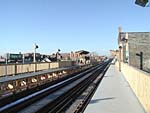
The Western-Hoyne temporary
station, perhaps the most refined of all the temporary
stations, is seen looking west on December 10, 2002. For a
larger view, click here.
(Photo by Graham
Garfield)
|
While the work is in progress, the temporary Western-Hoyne station
with entrances at Leavitt (two blocks east of Western) and at
Cullerton (a half block west of Hoyne) served customers from both
stations. The Western-Hoyne temporary station was placed in service
at 0400 hours on Monday, December 2, 2002. Customers continued making
bus connections with the #49 Western and the #X49 Western Express
buses at 21st/Western.
The temporary station featured temporary wooden dual side
platforms in the vicinity of Leavitt Street. These platforms fed from
the dual fare control areas at Leavitt (2200W) and Cullerton, a half
block west of Hoyne (2135W/2000S). This second entrance is unusual in
being the only temporary station entrance not located under the
tracks (like most of the temporary stations), but from the street
running parallel and to the north of the right-of-way. The fare
control areas consisted of concrete and asphalt floors, chainlink
walls, and wooden agent's booths. The platforms had wood decking and
railings, wooden canopies, and temporary signage largely relocated
from the closed Western and Hoyne stations.
During the weekend between the old stations' closures and the
temporary station's opening, after Western station was closed and
locked, CTA forces removed the
fare controls and AVMs in that station and relocated them to the
Leavitt entrance to the temporary station. The temporary station
remained in use while the old station was demolished and new station
built in its location over the following year and a half.

|
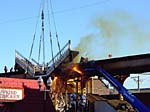
|
|
Left: By Monday,
October 21, 2002, the top row of tiles and the first two
feet or so of the glazed terra cotta had been removed from
Western's
Art Deco facade. The rest was removed by the end of the
week. For a larger view, click here.
(Photo by Graham
Garfield)
Right: Within a week
after the Western station closed, the platforms and canopies
had been removed, and the following weekend crews dismantled
the stairs to the platforms with blowtorches and cranes as
seen on December 8, 2002. For a larger view, click
here.
(Photo by Vern
Hallas)
|
Crews moved in quickly to begin demolishing the old station. Over
the weekend of December 7-8, 2002, demolition of the elevated
platform, stairs, and station house began. The green Art Deco
lettering along the top of the station facade was later removed
before the rest of the station house was demolished. Once the old
station was removed, Kiewit-Delgado, the Douglas project's primary
construction contractor, could begin construction of the new elevated
right-of-way, which bows out from the previous alignment to run
around the new, wider island platform. Work on the new elevated
right-of-way continued into early 2003.
Work was also underway at this point on the new island platform.
By late winter, nearly all of the platform structure and platform
decking was installed, including for the walkway over Western Avenue
to the auxiliary entrance/exit on the west side of the street. By
March 2003, work on the new station house at Western was underway,
including excavation for the building's foundation. By late spring,
steel for the new canopy began to be erected.
By June, the station foundation was in place and the stairway
between the street-level and platform and surrounding walls were in
place. The steel framework for the canopy was in place, as was the
elevator tower. During mid-Summer, work was undertaken to install the
canopy's roofing and work on the elevator tower continued and by
August, the steel frame for the station house itself began to be
erected. Installation of the canopy glazing and completion of the
soffit was undertaken by September. Work on the canopy continued into
Fall and by the end of 2003 efforts were underway to complete the
concrete platforms.
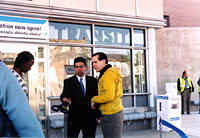
From left to right, CTA
Chairman Carole Brown, 25th ward Alderman Danny Solis, and
CTA President Kruesi open the new Western station on June 4,
2004. For a larger view, click here.
(Photo by Bruce
Moffat)
|
In early 2004, work at Western continued on various aspects
throughout the facility. The station house continued to be finished
out with additional storefront work and interior fixtures, and the
installation of the fascia on the vertical faces of the platform
canopy "triangles" and other nonstructural ornamental steel.
On June 4, 2004, the Chicago Transit Authority reopened Western
station, the sixth of eight stations new, rebuilt stations in the
rehabilitation of the Cermak (Douglas) branch of the Blue Line.
Chicago Transit Board Chairman Carole Brown and
CTA President Frank Kruesi
were joined by 25th Ward Alderman Danny Solis to announce the
reopening of Western.
"The newly renovated 'L' station at Western is an excellent
example of the work that the CTA is doing to bring its system to a
state of good repair," said
CTA President Frank Kruesi at
the time. "These enhancements mean better service and will help us
retain existing customers and attract new customers to the CTA."
Coincident with the new station opening, the Leavitt entrance
(2200W) to the temporary Western-Hoyne
station was closed and converted to an emergency exit . The station
did not close entirely until July 22, when the new Damen
station opened a half mile east. The temporary station was
subsequently dismantled over the weekend of August 7-8, 2004.
The Western station also had new original artwork installed as
part of the Douglas branch renovation. Included through a unique
partnership between the Chicago Department of Cultural Affairs'
Public Art Program and the
CTA , the Public Art Program
administered the selection, design, creation and installation of
public art for the project. Western's art installation, which is
outside the station and in front of the adjacent substation to the
south, is of particular interest to historians because it
incorporates the 1930s Art Deco facade that adorned the previous
station. The facade was carefully dismantled before the station was
demolished and put in storage while the facility was reconstructed.
As part of the Douglas art program, it was reassembled on a
purpose-built concrete wall in front of Western Substation. Inside
the facade, where the doors and windows had been in the old station,
a new Byzantine glass mosaic titled "Ice Cream Dream" by artist
Hector Duarte was assembled. The facade and artwork were installed
during November and December 2004. The
CTA allocated $1 million for
the Cermak Branch Art Project and retains ownership rights to all of
the artwork created.
After conducting a West Side Corridor Study and holding public
meetings during 2004 and 2005, the
CTA began operation of a new
service over the Cermak
branch. Beginning Sunday, June 25, 2006, the new Pink
Line began providing the primary rail service to the branch.
Operating seven days a week during the same service hours as the
Blue Line had operated,
Pink Line trains operated
on the Cermak branch
from 54th/Cermak to Polk,
then terminated around the Loop
via the Paulina
Connector and Lake
branch of the Green
Line. Service levels increased with the introduction of the
Pink Line, with trains
running more frequently including a 7.5-minute interval during
weekday rush periods. To address community concerns, Blue
Line service to the O'Hare
branch from 54th/Cermak via the
Dearborn
Subway was maintained during morning and afternoon rush hours.
The Pink Line and revised
Blue Line services were
instituted as an 180-day experiment, extended for additional 180-day
experimental periods subsequently, while ridership and other effects
were studied. As the experimental period continued, the
CTA revised service on the
Cermak branch to
eliminate the rush period Blue
Line trains, leaving the Pink
Line to provide all service to 54th/Cermak.
Although ridership had risen overall since the introduction of the
Pink Line, Blue
Line trains had consistently low ridership on a
person-per-railcar-basis. The last day of Blue
Line Cermak
service was Friday, April 25, 2008.
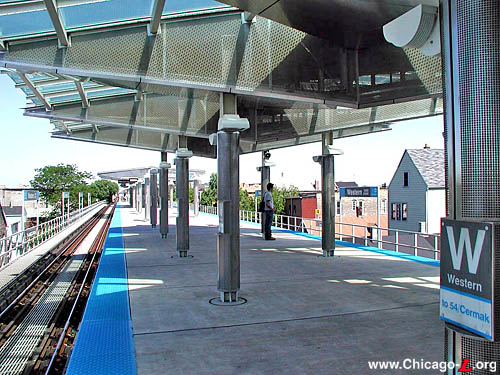
The
CTA's Douglas-standard "showpiece" canopy, seen looking east on
reopening day, June 4, 2004, has clear glazed roof sections
that allow natural light on the platform alternating with
triangular solid, three-dimensional metal wedges and clear
triangular panels that led the canopies to be dubbed by some
as the "flying triangles". For a larger view, click
here.
(Photo by Graham
Garfield)
|
 Old Western
(1896-2002) |
Temporary
Western-Hoyne (2002-2003) |
New Western
(2002-present)
Old Western
(1896-2002) |
Temporary
Western-Hoyne (2002-2003) |
New Western
(2002-present)

|
western03.jpg
(27k)
A dramatic, shadowed view of the front and and north
elevations of Western's Art Deco station house on November
19, 2000. (Photo by Teresa
Heinrichs)
|
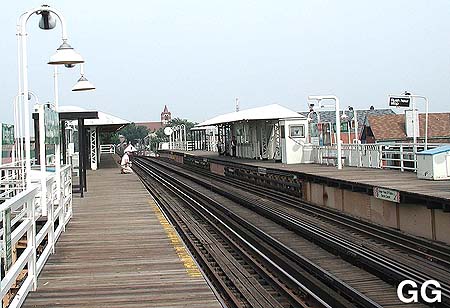
|
western04.jpg
(102k)
The dual side platforms at Western are seen here looking
east on the outbound platform on August 1, 2001. The
original canopies and much of the original railings were
still in place until late 2002. (Photo by
Graham Garfield)
|
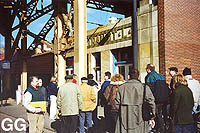
|
tour00m.jpg
(95k)
Participants in the 2nd
Annual Historic Station Tour walk around outside the
Western (Douglas) station, led by the tour guides, including
Keith Letsche (left). (Photo by Graham
Garfield)
|
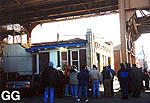
|
tour00n.jpg
(73k)
The 2nd Annual Historic Station
Tour group gathers outside the Western station on the
Douglas branch to hear comments from the tour guides.
(Photo by Linda Garfield)
|
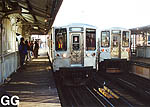
|
tour00o.jpg
(73k)
The two 2200-series
charter units pose side-by-side at the Western station on
the Douglas branch while some members of the 2nd
Annual Historic Station Tour group walk around the
station. (Photo by Graham
Garfield)
|
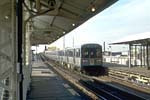
|
cta3187.jpg
(94k)
One of the few sets of unrehabbed 2600s
left on the system at the time, car 3187 brings up the rear
of an 8-car Blue Line train heading for 54/Cermak
as it leaves Western station on the Douglas branch on
October 29, 2001. (Photo by Mike
Farrell)
|
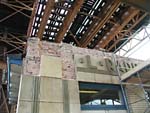
|
western07.jpg
(159k)
As the decorative tiles were removed, the common brick
underneath was revealed, seen here on October 21, 2002.
Workmen were as careful as possible not to damage any tiles
in the removal process. (Photo by Graham
Garfield)
|
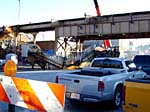
|
western09.jpg
(116k)
After sections of stairway, like this one on December 8,
2002, were removed from the elevated structure, they were
lowered to the street where they would be loaded onto
flatbed trucks and taken away for scrapping.
(Photo by Graham Garfield)
|
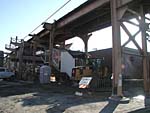
|
western10.jpg
(157k)
Only a week after the station closed, Western's station
house, canopies and platforms, along with most of its
stairs, were gone. In this December 10, 2002 view, all that
remains are the lower portion of the stairs, and they would
not be long for this Earth. (Photo by Graham
Garfield)
|
Temporary Western-Hoyne
station
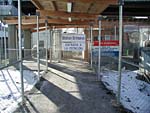
|
western-hoyne.cullerton01.jpg
(240k)
The Cullerton entrance to the Western-Hoyne temporary
station, seen on December 10, 2002, was the first to feature
bilingual signs. Other entrances followed afterward.
(Photo by Graham Garfield)
|
New Western
station
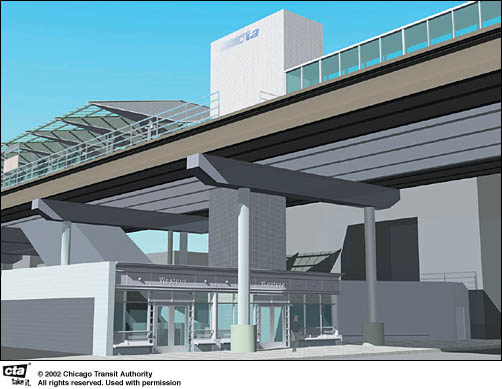
|
western05.jpg
(165k)
The design for the new Douglas stations, including
Western (pictured here), have a decidedly modern design,
with a simple box-shaped glass and steel building beneath
the elevated structure and an angular postmodern canopy, as
seen in this artist's rendering. (Drawing
provided courtesy of the Chicago Transit
Authority)
|
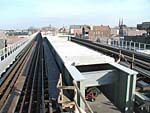
|
western11.jpg
(181k)
On February 6, 2003, the new Western island
platform is well underway, looking east at the completed
precast deck. The narrow section in the foreground is the
walkway to the auxiliary entrance/exit on the west side of
Western Avenue. (Photo by Graham
Garfield)
|
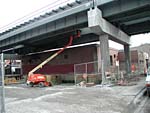
|
western12.jpg
(184k)
Foundation excavation work for the new Western
station house -- in the same location as the original
station house -- is underway in this view looking southeast
on March 18, 2003. (Photo by Graham
Garfield)
|
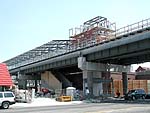
|
western13.jpg
(163k)
Looking southeast on June 24, 2003, only Western's
canopy and elevator framework at platform level and the
elevator and stairway enclosures in the future station house
had been constructed. (Photo by Graham
Garfield)
|
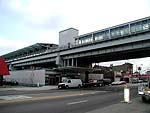
|
western14.jpg
(138k)
Looking southeast on December 8, 2003, the
station house is now largely built out and the canopy is
nearing completion. Also visible in this view is the
enclosed walkway over Western Avenue at track level to allow
easy access for passengers transferring to and from
southbound Western Avenue buses. The cement wall to the
right of the station house, in front of the substation, will
have the Art Deco facade from the former station mounted on
it as an art installation. (Photo by Graham
Garfield)
|
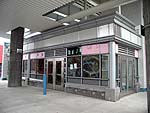
|
western15.jpg
(166k)
The station house exterior, typical of the new
Douglas stations, features large storefront-type windows in
an aluminum framework, a heavy cornice around the top, and
brackets for benches along the front. The pink band along
the top of the windows is a protective covering over
decorative art glass. Seen on December 8, 2003, one of the
protective coverings has been removed to reveal the pattern
beneath: the Art Deco lettering from the historic station
this station replaces. (Photo by Graham
Garfield)
|
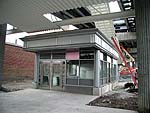
|
western16.jpg
(178k)
To allow convenient access for transferring bus
passengers to the station without having to cross extra-wide
Western Avenue, a small station house with high-barrier
gates is being constructed access from the main entrance,
seen looking west on December 8, 2003. Its design mimics the
main headhouse's. (Photo by Graham
Garfield)
|
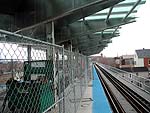
|
western17.jpg
(196k)
Looking east from the inbound track, the Western
platform's decking is installed and the canopy is
substantially in place, including its metal roofing and
glazing, on December 8, 2003. The fascia is being installed
on the vertical faces of the canopy structure.
(Photo by Graham Garfield)
|
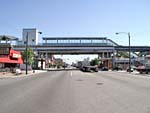
|
western21.jpg
(141k)
The auxiliary entrance on the west side of
Western (at right) is connected to the platform by way of a
platform-level pedestrian walkway bridge that spans the
width of Western Avenue. This bridge, seen here looking
south on June 4, 2004, creates a dominant profile over the
boulevard which is otherwise lined with one- and two-story
commercial and light industrial buildings.
(Photo by Graham Garfield)
|
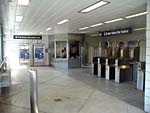
|
western22.jpg
(142k)
The interior of Western station, seen looking
north in the unpaid area on reopening day, June 4, 2004, has
a spacious interior. The walls are clad in white ceramic
glazed tile walls, the waiting area on the unpaid side has
seats of recycled plastic against the windows for waiting
bus riders, and it is finished off with stainless steel fare
controls, fare vending machines, and customer assistant
booth. (Photo by Graham Garfield)
|
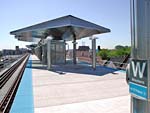
|
western23.jpg
(169k)
Looking west on the Western platform on reopening
day, June 4, 2004, one of the station's the triangular
canopies is up ahead. Freestanding light posts are covered
in the same "honeycomb" paneling that adorns the fascia of
the canopy wedges. (Photo by Graham
Garfield)
|
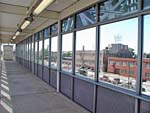
|
western25.jpg
(173k)
The bridge from the platform across Western
Avenue to the auxiliary entrance/exit, seen looking west on
June 4, 2004, has with one side enclosed with a metal framed
curtain wall with decorative art glass panels along the top
and the other with a decorative metal grille (out of frame
on the left) to protect customers from inclement weather.
(Photo by Graham Garfield)
|
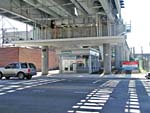
|
western26.jpg
(171k)
The exterior design of the auxiliary entrance and
exit on the west side of Western Avenue, across from the
main station house, resembles a miniaturized version of the
primary headhouse. The farecard-only entrance, seen looking
west on June 4, 2004, provides a more convenient option for
transferring to and from southbound #49 Western and #X49
Western Express buses. (Photo by Graham
Garfield)
|
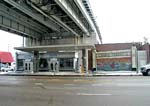
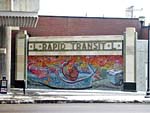
|
western28.jpg
(143k), left
western29.jpg
(187k), below left
Half a year after the new Western station opened,
a piece of specially-designed artwork was added to the
facility. Installed on a blank wall in front of Western
Substation, immediately to the south of the station house,
the installation incorporates the 1930s Art Deco facade that
adorned the previous station. Inside the facade, where the
doors and windows had been in the old station, a new
Byzantine glass mosaic titled Ice Cream Dream by
artist Hector Duarte was assembled. Seen here on January 21,
2005, the facade and artwork were installed during November
and December 2004. (Photo by Graham
Garfield)
|
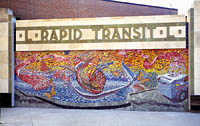
|
western-douglas_art01.jpg
(193k)
The mosaic Ice Cream Dream is seen mounted
within the 1935 Art Deco terra facade of the former Western
station, both mounted on a purpose-built wall in front of
Western Substation, next to the new Western station.
(Photo courtesy of CTA Arts in Transit
Program)
|
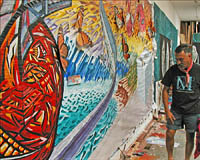
|
western-douglas_art02.jpg
(227k)
Artist Hector Duarte is seen in his studio
working on a mixed media version of Ice Cream Dream,
which he used as a basis for creating the glass and ceramic
pieces for the mosaic. (Photo courtesy of
CTA Arts in Transit Program)
|







































